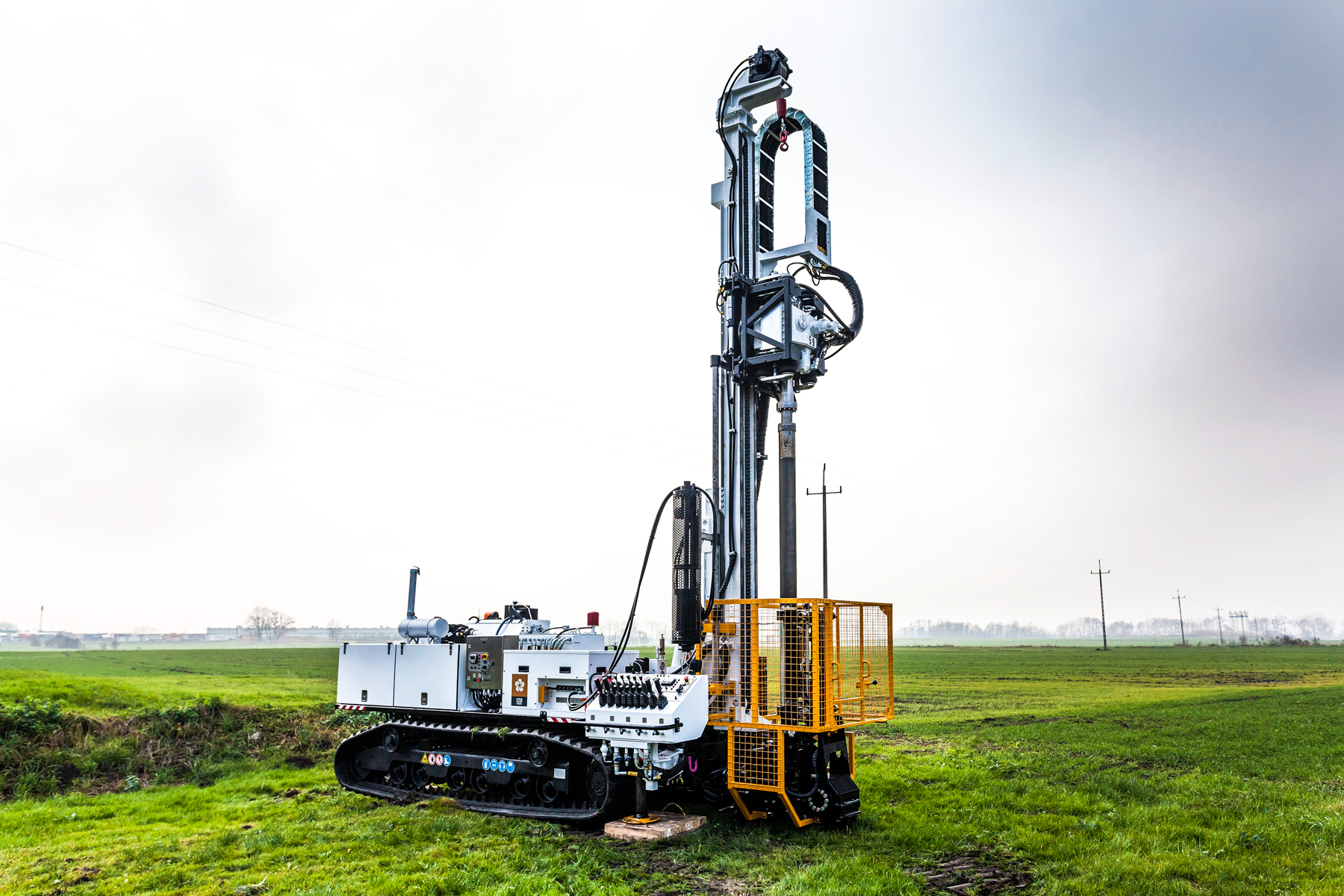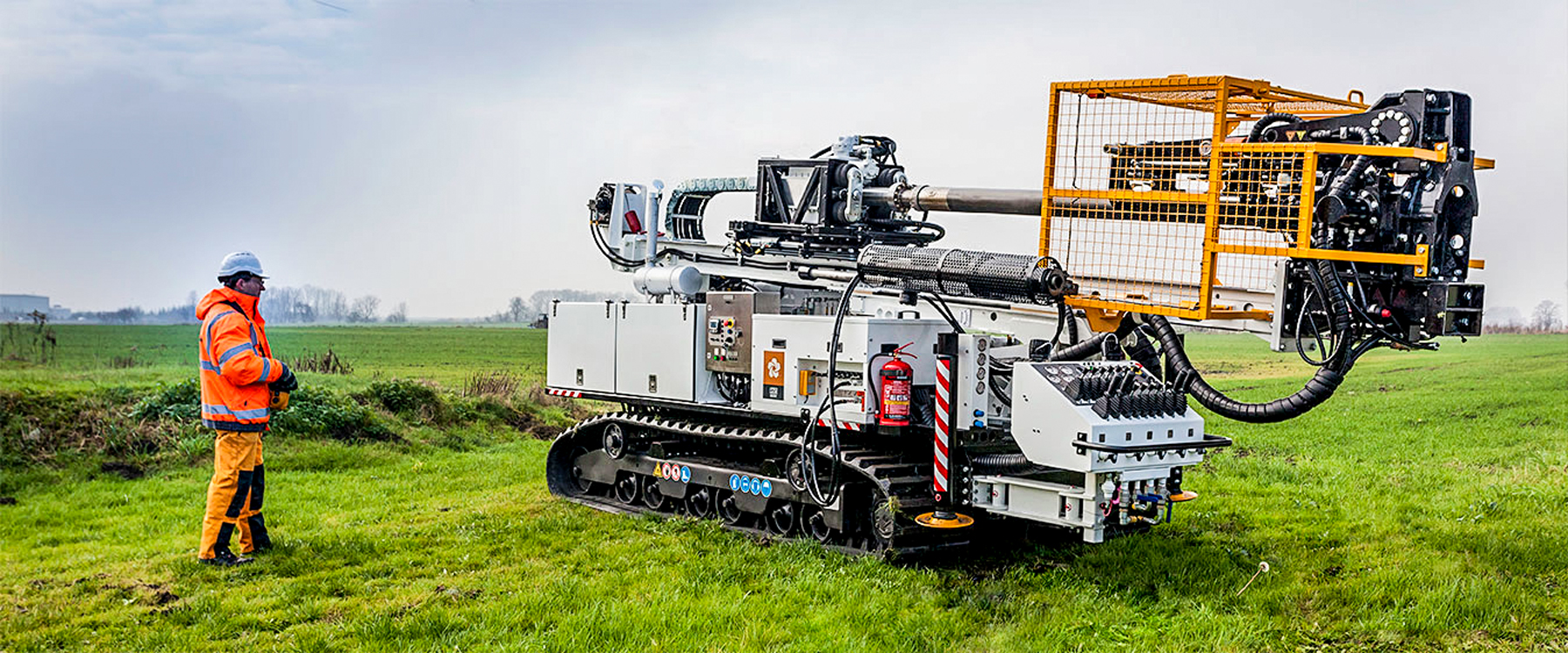NICHT MINING
18. Juli 2017
Kannst du es spüren? Die Sonic-Bohrtechnologie macht Fortschritte
Schallbohrungen werden zur bevorzugten Methode für eine Vielzahl von Herausforderungen.
Dieser Beitrag ursprünglich erschien in Nationaler Bohrer.
Von Bergungshalden an abgelegenen Minengebieten bis hin zu einem kontaminierten Standort in einem überlasteten Stadtteil: Schallbohrungen werden zur Methode der Wahl für eine Vielzahl von Herausforderungen.
Beim Sonic-Bohren werden ein zweizeiliges Bohrrohr und ein Gehäuse mit zwei Gewinden verwendet, wobei die innere Linie mit einem daran angebrachten Kernrohr vorgeschoben wird und die äußere Linie Lochstabilität erzeugt. Da bei der Probenahme keine Bohrflüssigkeit verwendet wird, führt diese "trockene" Probentechnik zu intakten Kernproben, die von Bohrflüssigkeiten nicht verändert werden.
Nach dem Vorschieben des inneren Bohrrohrs und des Kernrohrs wird das äußere Bohrergehäuse bis zu einem Fuß von der Vorderkante des Kernrohrs vorgeschoben.
Das Außengehäuse dient dem gleichen Zweck wie bei herkömmlichen Zweileiter-Bohrsystemen, indem es das Bohrloch für Bohrlochmontage, geophysikalische Protokollierung oder andere Bohrarbeiten offen hält. Je nach Bohrformationen kann während des Vorschubs des äußeren Bohrmantels Bohrfluid eingeführt werden.

Sonic Drilling reduziert auch das Risiko von Projektausfällen aufgrund unbekannter oder schwieriger Untergrundbedingungen. Es bietet auch die Flexibilität, ein temporäres Außengehäuse voranzutreiben, wenn das Bohrloch gebohrt wird. Das bedeutet, dass mit einem einzigen Bohrloch mehr erreicht werden kann.
Die Bohrmaschinen von Boart Longyear sind die erfahrensten Bohrer der Branche, die bis in die 1990er Jahre zurückreichen.

Obwohl die Einführung der Technologie nur langsam erfolgte, wird das Sonic-Bohren jetzt als Lösung für eine Vielzahl von Anforderungen angesehen. In kanadischen Ölfeldern zum Beispiel, in denen weiche Gesteinsformationen vorherrschen, erkennen Unternehmen zunehmend die Vorteile von Sonic gegenüber konventionellen Bohrmaschinen und Schneckenbohrern für viele Anwendungen.
Nach dem Misserfolg des Mount-Polley-Staudamms in British Columbia im Jahr 2014 hat die Provinzregierung die Installation von Überwachungsbohrungen und Piezometern an den Rückhaltepfählen in der gesamten Provinz angeordnet. Die schwierige Erreichbarkeit vieler Standorte und die mögliche Instabilität der Pfähle machten das neue LS250-MiniSonic-Rig von Boart Longyear zu einer naheliegenden Wahl.
Das zuverlässige, kompakte Schallgerät erweist sich als ideale Lösung für eine Vielzahl von Anwendungen, darunter Geotechnik, Umwelt, Wasser und Bergbau. Durch seine kompakte Größe kann es leicht zu schwer zugänglichen Stellen wie den Abhanghaufen transportiert werden oder in engen Räumen arbeiten.
Dies war in der Innenstadt von Calgary, Alberta, der Fall, wo ein bedeutender Sport- und Unterhaltungskomplex für ein unterentwickeltes Ufergebiet vorgeschlagen wird, das jetzt Autohäuser und eine Bushaltestelle umfasst. Obwohl ein Kreosotwerk vor Jahrzehnten geschlossen wurde, erstreckt sich das Kreosot über einen großen Teil des geplanten Entwicklungsgebiets.
Eine kürzlich durchgeführte Umweltuntersuchung erforderte Bohrungen an mehreren Stellen des Grundstücks. Sonic-Technologie und die Manövrierbarkeit der Bohranlage machten die Mission mit praktisch perfekten Kernproben möglich.
Bohren nach unten

Beim Sonic-Bohren wird hochfrequente resonante Energie verwendet, um einen Kernzylinder oder ein Gehäuse in unterirdische Formationen zu befördern. Während des Bohrens wird die resonante Energie mit verschiedenen Schallfrequenzen vom Bohrstrang auf die Bohrerfläche übertragen. Gleichzeitiges Drehen des Bohrgestänges verteilt die Energie und den Aufprall an der Bohrerspitze.
Die resonante Energie wird im Schallkopf durch vier gegenläufige Gewichte erzeugt. Ein patentiertes pneumatisches Isolationssystem verhindert, dass die resonante Energie auf die Bohranlage übertragen wird, und lenkt die Energie vorzugsweise vom Bohrstrang ab.
Der Bohrer steuert die von dem Schalloszillator erzeugte Resonanzenergie, um sich an die angetroffene Formation anzupassen, um eine maximale Bohrproduktivität zu erreichen. Wenn die resonante Schallenergie mit der Eigenfrequenz des Bohrstrangs übereinstimmt, tritt Resonanz auf.
Dies führt dazu, dass die maximale Energiemenge an das Gesicht abgegeben wird. Gleichzeitig wird die Reibung des Bodens, die unmittelbar an den gesamten Bohrstrang angrenzt, wesentlich minimiert, was zu sehr schnellen Eindringraten führt.
Sonic Vorteile
Sonic bietet verschiedene Vorteile gegenüber herkömmlichen Technologien. Dazu gehört die überlegene Information, die von der kontinuierlichen, relativ ungestörten Kernprobe mit beispielloser Qualität und Genauigkeit durch alle Arten von Boden geliefert wird - Lehm, Schüttgut, Sand, Kies, Felsbrocken oder Pflastersteine. Bei Verwendung des Iso-Flow-Grundwasser-Profilierungssystems können leicht hydrogeologische und geochemische Daten erhalten werden.
Sonic Drilling reduziert Bohrerabfälle und -abfälle im Vergleich zu herkömmlichen Bohrmethoden um bis zu 80 Prozent. Im Gegensatz zum Bohren mit einer Schnecke ist so gut wie keine Reinigung erforderlich.
Überlegene Brunnenbauweise ist ein weiterer Vorteil. Schallbohrungen verursachen minimale Störungen an der umgebenden Bohrlochwand, was zu einer effizienteren Bohrlochentwicklung und Leistung führt. Dann ist da noch die Geschwindigkeit. Sonic Drilling ist bis zu zwei bis drei Mal schneller als herkömmliche Abraumbohrverfahren.
Zu den Sicherheitsmerkmalen des LS250 MiniSonic-Rig gehören eine verriegelte Rotationsbarriere, ein reduzierter Geräuschpegel, ein Muldenmast und ein Wackelschwanz sowie ein Rutenaufgeber. Die verriegelte Rotationsbarriere verlangsamt automatisch die Kopfdrehung, wenn die Barriere geöffnet ist. Das Gerät bietet außerdem einen niedrigeren Geräuschpegel, wenn es mit dem Tier 4i-Motorpaket ausgestattet ist.
Der gelenkige Mast und das wackelnde Heck ermöglichen es dem Mast, sich von links nach rechts und von vorne nach hinten zu bewegen, um den Mast präzise über dem Loch zu positionieren, wodurch zeitaufwändige Bohrbewegungen entfallen. Dank des Kippmastes kann die Crew vom Boden aus arbeiten. Dies erhöht die Sicherheit, da Treppen und Sicherheitsgeländer beim Arbeiten von einer Plattform aus oft vermieden werden.
Der innovative Stangenvorführer ermöglicht die horizontale Beladung der Stange und des Gehäuses, wobei ein Stellglied die Stange und das Gehäuse senkrecht zum Kopf präsentiert. Der Kopf kann zur Probenentnahme um 28 Grad zur Seite gedreht werden, während die Verschiebung des Kopfgleiters den ungehinderten Einsatz der Winde im Loch ermöglicht.
Was kommt als nächstes?
Mit dem MiniSonic-Bohrgerät LS250 können Bohrungen bis zu einer Tiefe von bis zu 78 Metern in einem 121-Millimeter-Gehäuse durchgeführt werden. Sein „großer Bruder“, das LS 600 Sonic Rig, kann noch tiefer gehen - bis zu 182 Meter (600 Fuß), wie der Name schon sagt. Die Boart Longyear-Produktpalette umfasst auch hochwertige Klangwerkzeuge, von Bit- und Gehäuseschuhen bis zu Schallruten, Kernrohr, Gehäuse und Zubehör.
Da das Bewusstsein für die Vorteile von Schallbohrungen immer größer wird und immer mehr Geotechnikingenieure Schall vorgeben, wird der Markt wahrscheinlich fortlaufende Innovationen und Schallbohrungen erfordern, die noch tiefere Proben mit größerem Durchmesser ermöglichen. Und Boart Longyear, der bereits an der Spitze der Schallbohrung steht, wird weiterhin die Führung übernehmen.
Um mehr über das LS250 MiniSonic-Rig von Boart Longyear zu erfahren, besuchen Sie www.BoartLongyear.com/MiniSonic.




